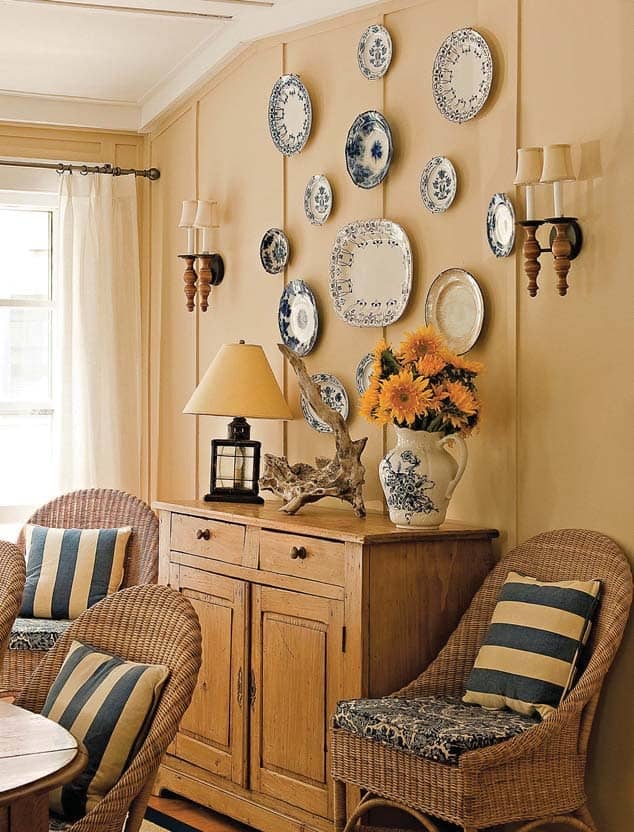Prøve GULL - Gratis
displaying collections ARRANGE TO INSPIRE
Old House Journal
|January - February 2022
Ideas, inspiration, and tidbits on the beautiful and safe arrangement and display of collectibles both traditional and eccentric.

People collect all kinds of things: pottery and silverware, sure, but also souvenir Statues of Liberty, vintage quilts, geodes, wind-up toy snails, manual typewriters, seascapes, wax fruit, and tiny succulent houseplants. Regardless of the value (or even the quality) of a collection, how it is displayed makes the difference between its being clutter and art. In a curated display, the whole is more than the sum of its parts. Separate objects become a unit that tells a story. This is true whether the collected objects are hung on a wall, placed on a narrow shelf, arranged in a cabinet—or occupy their own gallery wing.

displaying GLASS
Because of its translucence, glass is best displayed so that light moves through it. Consider glass front cabinets with subtle integrated lighting. A mirrored back, or a mirror placed behind glass on a shelf, shows off both sides of the objects and also bounces light through them. A very effective and inexpensive display is on glass shelves set into a window well, backlit by daylight or a light source. Colored glass in a window will throw colored light into the room, changing with the angle of the sun. Glass objects can simply sit on a windowsill for a similar result. A very different effect is produced depending on whether all of the glass is in one color, or if colors are mixed.

• For displays more than one object deep, glass is effective placed in front of white porcelain or stoneware.

Denne historien er fra January - February 2022-utgaven av Old House Journal.
Abonner på Magzter GOLD for å få tilgang til tusenvis av kuraterte premiumhistorier og over 9000 magasiner og aviser.
Allerede abonnent? Logg på
FLERE HISTORIER FRA Old House Journal

Old House Journal
designing built-in living spaces
I want an alcove just for me. Kind of like a hideout separate from the commotion in the rest of the house from which to read, write, nap, or just daydream. I want to be aware of the action in the house but be able to turn my shoulder politely and be by myself. So goes the design brief from one of our clients. She's not alone in her desire for personal scale and place-making in home design; this is a common human need.
1 mins
January - February 2026

Old House Journal
ASK OHJ
For the past year or so, the brick surround of my fireplace (below the opening, underneath a stone hearth) has been producing a white-ish dust.
4 mins
January - February 2026

Old House Journal
a bungalow Out West
A restoration prodigy restores a 1915 Arts & Crafts bungalow in Sheridan, Wyoming, and that leads to a successful career.
2 mins
January - February 2026

Old House Journal
Just the way it was
Original elements remain in this 1914 Prairie-influenced house: handsome wood and leaded windows, the brick fire-place, wainscot and trim, and even kitchen cabinets. Deftly added upgrades in period mode enhance the exemplary restoration.
2 mins
January - February 2026

Old House Journal
Matching Old Mouldings
There comes a time in the life of every old-house owner when we need to match a section of existing wood moulding.
4 mins
January - February 2026

Old House Journal
Victorian Update
A sophisticated kitchen renovation corrects anachronisms in an 1891 house undergoing restoration.
2 mins
January - February 2026

Old House Journal
NEW INSULATION FOR OLD WALLS
If after insulating the attic, weather-stripping windows, and addressing infiltration, an energy audit recommends upgrading wall insulation, the first step is to find out what's already in there, if anything.
1 mins
January - February 2026

Old House Journal
Finishing Secrets FOR FURNITURE-GRADE TRIM
Whether you're staining a door, built-in cabinetry, or any of the millwork in between, follow these steps for a flawless finish.
5 mins
January - February 2026

Old House Journal
art deco BATHS IN BLACK & WHITE
OWNERS OF A 1926 HOUSE DECIDE TO LOOK BACK TO THE ERA WHEN IT WAS BUILT, EMBRACING BOLD LUXURY.
2 mins
January - February 2026

Old House Journal
English Garden Inspiration
In what was an old Columbus schoolyard, Hoerr Schaudt Landscape Architects introduce a profusion of color and pattern.
2 mins
Winter 2026
Translate
Change font size
